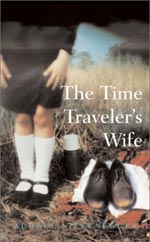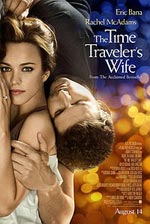
Between the Novel and the Script
I just saw the movie adaptation of The Time-Traveler’s Wife, the best-selling novel by Audrey Niffenegger. Eric Bana was the only reason I don’t regret buying the ticket. I’d had such high hopes because the novel was so compelling. It seemed like it had the perfect plot for a gifted director to bring to life. I’m not sure what happened, but something was lost between the pages of the novel and the pages of the script. Was it the emotion between characters? The effortless threading back and forth from one point in time to another? The world I had so effortlessly inhabited inside my own head seemed flat and lifeless when I saw it projected onto a theater screen.
Can a good book ever be a good movie? After such a recent disappointment, with the sense of superiority accompanying having read books instead of watching cartoons as a child, my first instinct was to sneer at the possibility. Everyone knows that the subtlety of language and characters and thematic development that characterize the best novels or nonfiction don’t translate into the more pedestrian realm of acting. The Time Traveler’s Wife is just the latest in a series of not-so-good movies adapted from oh-so-good books.
But then I started looking at my bookshelves, and what I saw surprised me. Gone with the Wind received ten Academy Awards. Seabiscuit was a fabulous piece of nonfiction, but I didn’t discover the book until after I’d seen the movie. Dr. Zhivago inspired not just a lovely film but also a soundtrack that remains immediately identifiable. And then perhaps the biggest surprise of all: J. R. R. Tolkien’s The Lord of the Rings trilogy, made into films that somehow captured both the subtlety and the drama of the world imagined into being, complete with its own languages.
What’s the difference between adaptations that work and those that make us shudder at the “adapted from the novel” tagline below the titles? The devil is in the details. When Tolkien wrote about the round, green door at the entrance to Bilbo Baggins’ hobbit hole, or Margaret Mitchell highlighted Scarlett O’Hara’s green eyes and matching ballgown in the opening scenes at Tara, both authors were ushering their readers into a world that is no less real for being imaginary. Changing the shape of a door during set construction or the color of an actress’s eyes doesn’t alter the plot, but it creates a jarring contrast and a sense that something is wrong for all those in the audience who know what this world should be. In building a set and casting an actress who so perfectly fit their original descriptions, Peter Jackson and David Selznick gain the trust of the reader-turned-moviegoer for those moments when film must inevitably differ from print.
Perhaps even more difficult is achieving the “feel” of a story, those things that aren’t described in physical detail by the author of a novel, but instead reflect the way in which great writing paints a picture of emotions. This is the art of translation—from words on a page to visual images on a screen—that separates the best film directors from those who simply make movies. Dr. Zhivago’s “Lara’s Theme” remains iconic as a movie soundtrack because it perfectly captures the tragedy of love found amidst the horrors of war and politics. And how to show the intricacies of a love affair between an immortal elf and a mortal man, a relationship that even the author who created it found so complex he had to tell the story in an appendix to the novel? Peter Jackson fired the actor originally signed to play Aragorn in the Lord of the Rings trilogy—the day before shooting began—simply because he didn’t “look” the part. Such decisions make movie executives nervous, but when an audience has to rely on an actor’s on-screen aura to portray everything that an author can narrate in prose, the chemistry between actor and camera, and between actors themselves, becomes irreplaceable.
I think I will always prefer a good book to a good movie; some habits are ingrained too deeply to change. But if done well, words on a page can be adapted to the silver screen. And next up on the list of possibilities? A Christmas Carol, opening Friday. Can Jim Carrey and Disney do Charles Dickens? I’m skeptical, but willing to be convinced.


